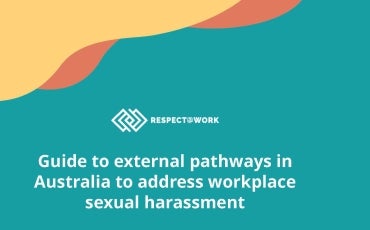Investing in workplaces that work for everyone (2021)

Executive Summary
This report presents research into the collection and reporting of workplace data relevant to sexual harassment by ASX200 companies. The research, led by the Sex Discrimination Commissioner, Kate Jenkins, on behalf of ACSI, is based on a comprehensive survey of 118 ASX200 companies, as well as in-depth interviews with representatives of 16 ASX200 companies. The report provides insights into how companies currently collect and use data relating to sexual harassment, and based on those insights, makes recommendations about the role the boards of large Australian companies can and should play in preventing and responding to workplace sexual harassment. Additionally, the report highlights actions investors can take to manage financial risks associated with workplace sexual harassment within investee companies.
Clearly, collection of information alone is not enough to prevent and address sexual harassment. The report finds a range of maturity across the ASX200 companies when it comes to using the information to manage this material risk. Information must be analysed, shared and acted upon for it to be useful. If information is not appropriately escalated within an organisation, risk cannot be effectively and proactively managed by those responsible.
The report recommends that boards focus on oversight of prevention of as well as response to sexual harassment. Boards should take primary responsibility and accountability for ensuring the company has in place a governance framework for sexual harassment, and for monitoring performance against this framework across the organisation. The board should also clearly identify the information it expects to receive in monitoring performance, including information to assess how effective the organisation’s systems are in preventing, as well as responding to, sexual harassment.
Key statistics and recommendations are set out below.
Key statistics
Leadership and governance
It can be unclear who holds primary responsibility and accountability for the prevention of and response to sexual harassment.
19% of survey respondents recognised that the board had primary responsibility and accountability for the prevention and response to sexual harassment, including the oversight of policies and frameworks that support the gathering and use of data. Instead, in most companies, primary responsibility sits with senior executives (Head of Human Resources or the CEO). For many companies, the responsibility is shared and can be unclear.
Fewer than half of respondents indicated that sexual harassment was a regular board agenda item (43%). We heard that external events often served as a prompt for board discussion, suggesting that the majority of boards have been taking a reactive, rather than proactive or preventative, approach to addressing sexual harassment.
Risk assessment
64% of respondents had developed a mechanism that identified and mitigated risk factors for sexual harassment.
Gender diversity and expertise
Gender diverse boards and access to relevant expertise is correlated with stronger governance and oversight of matters regarding sexual harassment.
62% of respondents had set a target to increase representation of women on their board.
Gender equality was a priority for the majority of respondents (94%) who indicated they have policies and strategies in place to support gender equality in recruitment.
Culture
The majority of respondents indicated that they tied the EMT’s remuneration and performance incentives with culture and conduct standards. 27% reported that they tied incentive payments, at least partially, to preventing sexual harassment.
Knowledge building
Directors and EMT would benefit from additional skills and expertise on good governance and sexual harassment.
19% of respondents reported that board directors undergo training on good governance and sexual harassment.
Three out of five respondents (60%) indicated that the EMT was required to undergo training on good governance and sexual harassment.
Reporting and supports
The majority of respondents had a range of complaint options available, however practices in respect of follow up and monitoring varied.
While the majority of companies had a range of avenues available to report sexual harassment, there is an opportunity to strengthen systems to evaluate the effectiveness of complaints procedures, provide supports to involved parties, and follow up with involved parties to a complaint.
Measurement and accountability
Respondents collected a broad range of information regarding corporate culture, including the prevalence of sexual harassment, but that there is opportunity to improve the way data is used and reported, especially on an industry basis.
Transparency
There is inconsistency in respect of information sharing internally. In addition, less than one third publicly reported information relevant to sexual harassment as recommended by the ASX Corporate Governance Principles and 14% of respondents did not report externally at all.
Recommendations
Recommendation 1: Leadership
Demonstrate visible leadership and appropriate oversight and governance over culture, sexual harassment and gender equality. The board has primary responsibility and accountability for ensuring that the entity has in place a governance framework for the prevention of and response to sexual harassment, and for monitoring performance across the entity.
Recommendation 2: Skills and experience
Ensure the entity has the skills and experience to effectively prevent and respond to workplace sexual harassment.
Recommendation 3: Culture
Make gender equality a priority and set gender diversity targets.
Recommendation 4: Systems and frameworks
Ensure systems and frameworks are in place to collect, analyse and use data to effectively manage the risks related to sexual harassment.
Recommendation 5: Executive alignment
Align appointment, expertise and performance management of the CEO and EMT with the entity’s values to ensure that EMT demonstrates and displays visible leadership on culture, sexual harassment and gender equality.
Recommendation 6: Use transparency to drive outcomes
Report internally and externally to measure and track the effectiveness of systems and frameworks to prevent and manage sexual harassment.
Investors
It is important to acknowledge that institutional investors are also a workplace and the recommendations set out above will equally apply to their entities. In addition, investors have an ongoing responsibility to protect and enhance investment value. To that end, the Commission makes the following further recommendations for investors:
Recommendation 7: Seek information on investee entities systems and processes to prevent and address sexual harassment
Recommendation 8: Advocate for improved transparency and public disclosure on sexual harassment
Investors should encourage their investee entities to disclose their approach to prevent and respond to sexual harassment.



